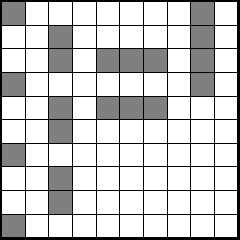Problems
A target consists of a triangle divided by three families of parallel lines into 100 equilateral unit triangles. A sniper shoots at the target. He aims at a particular equilateral triangle and either hits it or hits one of the adjacent triangles that share a side with the one he was aiming for. He can see the results of his shots and can choose when to stop shooting. What is the largest number of triangles that the sniper can guarantee he can hit exactly 5 times?
Is it possible to arrange the numbers 1, 2, ..., 60 in a circle in such an order that the sum of every two numbers, between which lies one number, is divisible by 2, the sum of every two numbers between which lie two numbers, is divisible by 3, the sum of every two numbers between which lie six numbers, is divisible by 7?
A set of weights has the following properties: It contains \(5\) weights, which are all different in weight. For any two weights, there are two other weights of the same total weight. What is the smallest number of weights that can be in this set?
A game of ’Battleships’ has a fleet consisting of one \(1\times 4\) square, two \(1\times 3\) squares, three \(1\times 2\) squares, and four \(1\times 1\) squares. It is easy to
distribute the fleet of ships on a \(10\times
10\) board, see the example below. What is the smallest square
board on which this fleet can be placed? Note that by the rules of the
game, no two ships can be placed on horizontally, vertically, or
diagonally adjacent squares.

On an 8×8 grid (like a chessboard), an L-corner is a shape made of 3 little squares of the board that touch to make an L. You can turn the L any way you like. We place the L-corners so that none overlap. What is the fewest L-corners you must place so that no more L-corners can be added anywhere? Here is an example of how three L-corners may look like:

An airline flew exactly 10 flights each day over the course of 92 days. Each day, each plane flew no more than one flight. It is known that for any two days in this period there will be exactly one plane which flew on both those days. Prove that there is a plane that flew every day in this period.
10 children, including Billy, attended Billy’s birthday party. It turns out that any two children picked from those at the party share a grandfather. Prove that 7 of the children share a grandfather.
Three circles are constructed on a triangle, with the medians of the triangle forming the diameters of the circles. It is known that each pair of circles intersects. Let \(C_{1}\) be the point of intersection, further from the vertex \(C\), of the circles constructed from the medians \(AM_{1}\) and \(BM_{2}\). Points \(A_{1}\) and \(B_{1}\) are defined similarly. Prove that the lines \(AA_{1}\), \(BB_{1}\) and \(CC_{1}\) intersect at the same point.
Two ants crawled along their own closed route on a \(7\times7\) board. Each ant crawled only on the sides of the cells of the board and visited each of the 64 vertices of the cells exactly once. What is the smallest possible number of cell edges, along which both the first and second ants crawled?
101 random points are chosen inside a unit square, including on the edges of the square, so that no three points lie on the same straight line. Prove that there exist some triangles with vertices on these points, whose area does not exceed 0.01.